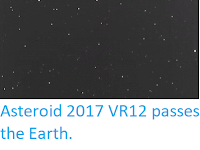Asteroid 2007 LU19 passed by the Earth at a distance of about 7 851 000
km (20.4 times the average distance between the Earth and the Moon, or 5.25% of the distance between the Earth and the Sun), slightly after 9.20 pm
GMT on Saturday 10 March 2018. There was no danger of
the asteroid hitting us, though were it to do so it would have
presented a significant threat. 2007 LU19 has an estimated
equivalent
diameter of 100-330 m (i.e. it is estimated that a spherical object
with
the same volume would be 100-330 m in diameter), and an object of this
size would be predicted to be capable of
passing through the Earth's
atmosphere relatively intact, impacting the ground directly with an
explosion that would be 225 to 120 000 times as powerful as the
Hiroshima
bomb. Such an impact would result in an impact crater 1-5 km
in
diameter
and devastation on a global scale, as well as climatic effects that
would last years or even decades.
The calculated orbit of 2007 LU19. Minor Planet Center.
2007 LU19 was discovered on 15 June 2007 by the Siding Spring Observatory near Coonabarabran in New South Wales. The designation 2007 LU19 implies that it was the 495th asteroid
(asteroid U19) discovered in the first half of June 2007 (period 2007 L).
2007 LU19 has a 1332 day orbital period and an eccentric orbit
tilted at an angle of 2.60° to the plane of the Solar System, which
takes it from 0.89 AU from the Sun (i.e. 89% of he average distance at
which the Earth orbits the Sun) to 3.84 AU from the Sun (i.e. 384% of the
average distance at which the Earth orbits the Sun, and more than twice
as distant from the Sun than the planet Mars). It is therefore
classed as an
Apollo Group Asteroid (an asteroid that is on average further from the
Sun than the Earth, but which does get closer). This means that close
encounters between the asteroid and Earth are extremely common, with the
last having occurred in June 2007 and the next predicted
in March 2029. As an asteroid probably larger than 150 m in diameter
that occasionally comes within 0.05 AU of the Earth, 2007 LU19 is also
classified as a Potentially Hazardous Asteroid.
2007 LU19 also
has frequent close encounters with the planets Mars, which it last came close to in March 1960 and is
next predicted to
pass in May 2098, and Jupiter which it last came close to in July 1987
and
is next predicted to pass in August 2022. Asteroids
which make close passes to multiple planets are considered to be in
unstable orbits, and are often eventually knocked out of these orbits by
these encounters, either being knocked onto a new, more stable orbit,
dropped into the Sun, knocked out of the Solar System or occasionally
colliding with a planet.
See also...
Follow Sciency Thoughts on Facebook.







